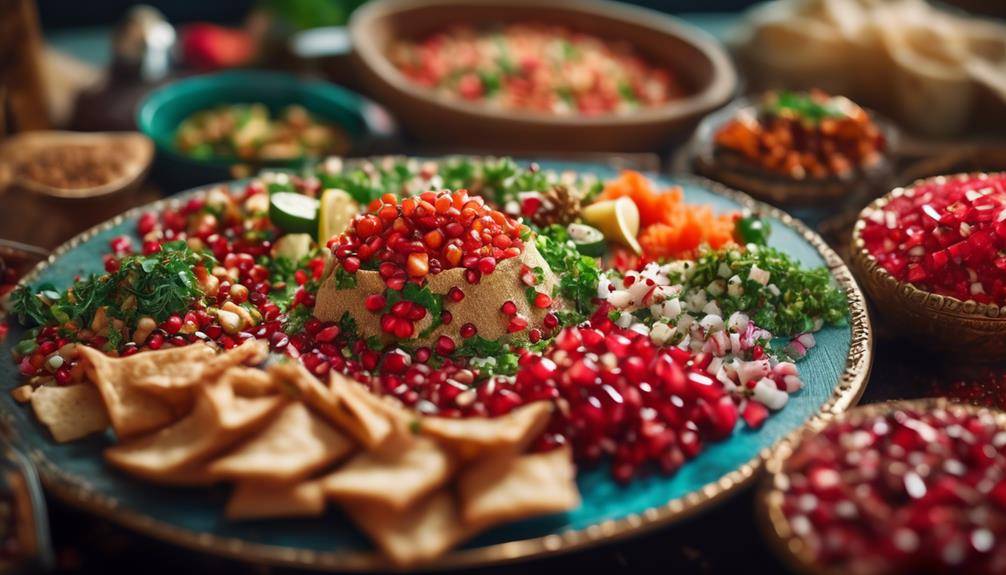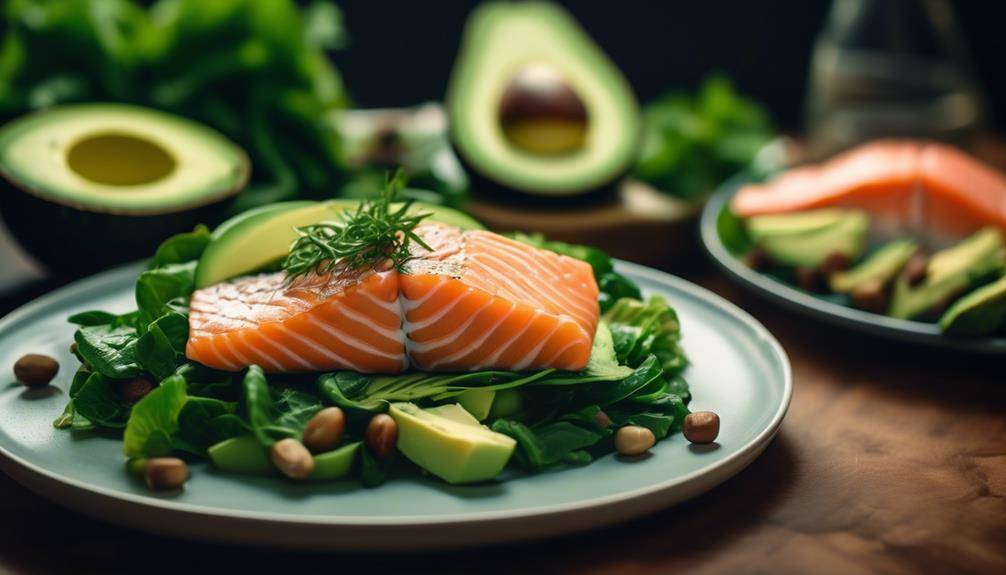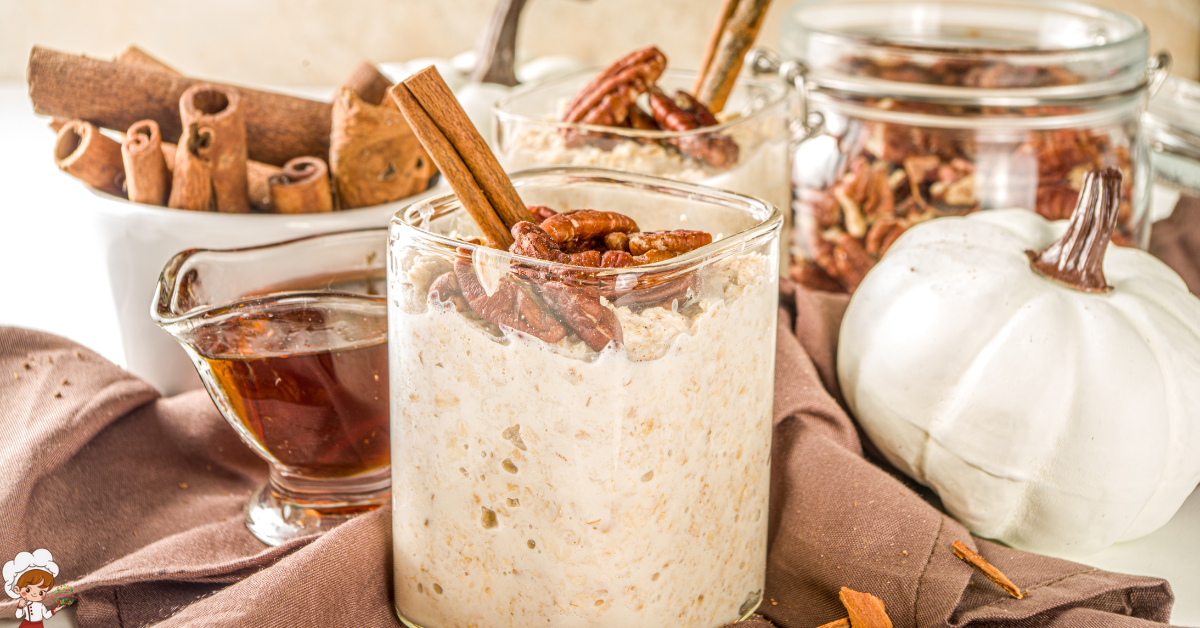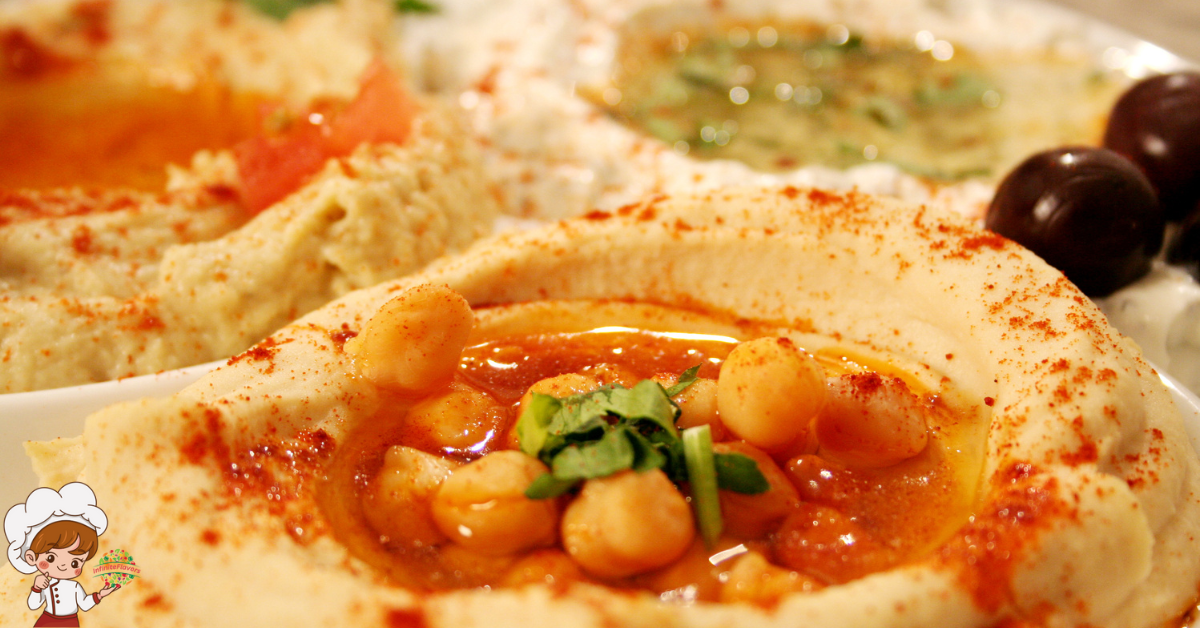The 6 Best Egyptian Breakfast Dishes And Recipes
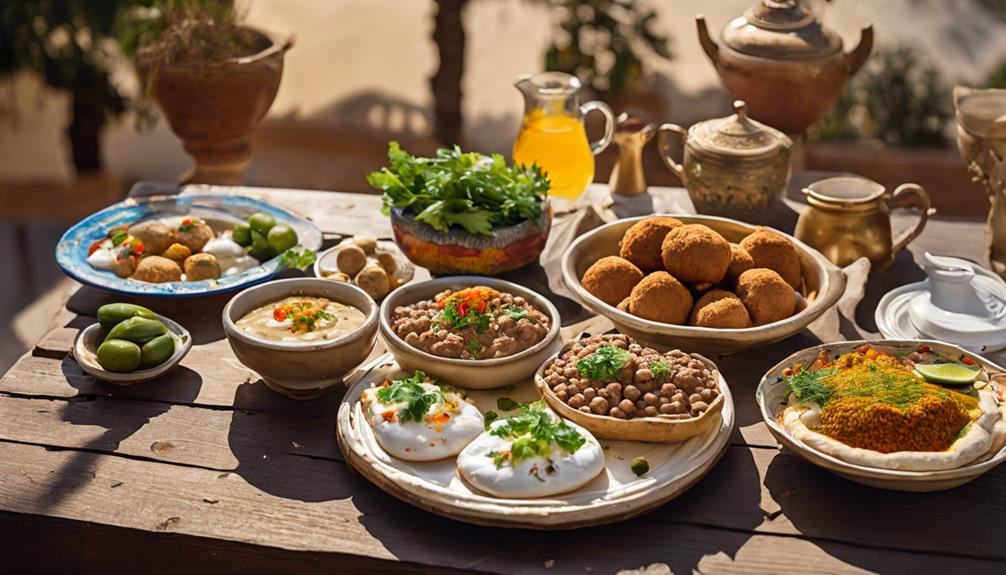
You’re in for a treat with The 6 Best Egyptian Breakfast Dishes And Recipes! Start your day with Ful Medames, a hearty fava bean dish, or try Ta’ameya, the crispy Egyptian falafel. Don’t miss Feteer Meshaltet, delicious layered pancakes that can be sweet or savory. Shakshuka, featuring poached eggs in a spicy tomato sauce, provides bold flavors. For something sweet, enjoy Basbousa, a semolina cake soaked in syrup. Each dish is packed with history and flavor. If you’re curious about the recipes and how to make these delightful meals, there’s plenty more to explore!
Ful Medames
Ful Medames is a beloved staple in Egyptian cuisine, and it’s often enjoyed as a hearty breakfast. This dish consists primarily of fava beans that are slowly cooked until they’re tender and creamy. You’ll appreciate its rich and earthy flavor profile, which is enhanced by a drizzle of olive oil, a squeeze of fresh lemon juice, and a sprinkle of cumin. The combination of these ingredients creates a delightful balance of savory and tangy notes that’s sure to awaken your taste buds.
As you dig into a bowl of Ful Medames, you’ll not only savor the taste but also benefit from its impressive nutritional profile. Fava beans are packed with protein, making this dish an excellent choice for a filling breakfast that keeps you energized throughout the day. They’re also rich in fiber, which helps with digestion and promotes a sense of fullness. Plus, the healthy fats from olive oil contribute to heart health while providing essential nutrients.
You can customize your Ful Medames by adding toppings like chopped parsley, diced tomatoes, or even a spicy chili sauce for an extra kick. Pair it with some warm pita bread, and you’ve got a satisfying meal that nourishes both body and spirit. Whether you’re enjoying it at home or in a local café, Ful Medames is a delicious way to start your day and embrace the culinary traditions of Egypt. So, go ahead and indulge in this delightful dish!
Ta’ameya
Savoring the crispy, golden-brown exterior of Ta’ameya is an experience that many Egyptians cherish for breakfast. This beloved dish, often referred to as Egyptian falafel, is primarily made from fava beans, which give it a distinct flavor and texture. As you bite into it, you’ll discover the soft, herby interior filled with fresh ingredients like parsley, cilantro, and green onions.
The history of Ta’ameya dates back to ancient times, with its origins rooted in Egyptian cuisine. While falafel made from chickpeas has gained international popularity, Ta’ameya remains a staple in Egypt, showcasing the country’s unique culinary traditions. You might be surprised to learn that the name “Ta’ameya” is derived from the Arabic word for “food,” emphasizing its significance in everyday meals.
Exploring Ta’ameya variations can elevate your breakfast experience. Some people enjoy it with pickled vegetables, while others prefer it drizzled with tahini or served alongside tangy salads. You may also encounter regional differences, with certain areas adding spices like cumin or coriander to enhance the flavor.
No matter how you choose to enjoy Ta’ameya, its crispy edges and savory filling will surely leave you wanting more. Pair it with fresh bread or a side of ful medames, and you’ve got yourself a hearty, satisfying breakfast that embodies the essence of Egyptian culture. So, give Ta’ameya a try and savor every delightful bite!
Feteer Meshaltet
Feteer Meshaltet is a flaky pastry that’s a staple in Egyptian breakfasts. You’ll appreciate the traditional preparation techniques that make it so special, from layering the dough to achieving that perfect crispiness. Let’s explore how it’s typically served and the delicious variations you can try.
Traditional Preparation Techniques
Crafting Feteer Meshaltet requires both skill and patience, as this flaky pastry reflects the heart of Egyptian culinary tradition. To start, you’ll need to gather high-quality ingredients, focusing on flour, water, salt, and fat. Ingredient sourcing is fundamental; using fresh, local products enhances the flavor and texture of your pastry.
Once you’ve got everything, the first step is mixing the flour and salt before gradually adding water to form a soft dough. Kneading the dough is essential, as it develops the gluten structure that gives the pastry its characteristic flakiness. After the dough rests, divide it into smaller balls and let it rise, allowing the gluten to relax.
When it’s time to roll out the dough, you’ll use a combination of stretching and folding techniques. This is where the cooking methods come into play—each layer you create adds to the flakiness. After rolling and layering, you’ll cook the Feteer Meshaltet on a hot griddle or in a traditional oven until golden brown and crispy. The result is a delicious pastry that showcases the rich culinary heritage of Egypt, perfect for any breakfast table.
Popular Serving Suggestions
A delightful breakfast experience awaits when you serve Feteer Meshaltet with a variety of toppings and accompaniments. This flaky pastry is incredibly versatile, allowing you to customize it according to your taste. One popular serving suggestion is to offer it with honey or powdered sugar for a sweet treat. For a more savory option, consider adding a mixture of cheese, herbs, or even a spicy tomato sauce to elevate the flavors.
Don’t forget to explore unique spice combinations that can enhance your Feteer Meshaltet. A sprinkle of za’atar or a dash of sumac can add an aromatic twist that delights the palate. Fresh vegetables, such as cucumbers or tomatoes, can also be served on the side, adding a invigorating crunch.
Incorporating traditional serving customs can make your breakfast even more special. Consider presenting the Feteer on a large platter, allowing everyone to tear off pieces and share. This communal approach not only fosters a sense of togetherness but also highlights the joy of enjoying food with loved ones. Whether sweet or savory, Feteer Meshaltet is sure to impress at your breakfast table!
Shakshuka
Shakshuka is a vibrant and flavorful dish that’s become a beloved staple in Egyptian breakfasts. It’s a simple yet satisfying meal made primarily from poached eggs nestled in a spicy tomato sauce. You can enjoy it any time of day, but there’s something special about savoring it in the morning.
To prepare shakshuka, you typically start by sautéing onions, garlic, and bell peppers in olive oil. Then, you add crushed tomatoes and spices like cumin, paprika, and chili, letting it simmer until it thickens. Finally, you make little wells in the sauce and crack eggs into them, cooking until the whites are set but the yolks remain runny. This cooking method allows the flavors to meld beautifully, creating a dish that’s both hearty and comforting.
What’s great about shakshuka is its versatility. You can easily customize it with ingredient variations to suit your taste. For instance, some people like to add feta cheese for a creamy touch, while others might include spinach or chickpeas for added nutrition. You can even experiment with different spices, like harissa for extra heat or fresh herbs like parsley for a burst of freshness.
Whether you enjoy it with crusty bread or pita, shakshuka is sure to become a favorite. Its combination of robust flavors and comforting textures makes it not just a meal, but an experience that captures the essence of Egyptian cuisine.
Egyptian Pancakes
Egyptian pancakes, known as “feteer,” are a delightful addition to any breakfast spread, offering a unique twist on traditional pancakes. These layered delights are flaky, crispy, and can be customized with a variety of fillings, creating a perfect canvas for Egyptian flavors. You can enjoy them sweet or savory, making them a versatile choice for your morning meal.
To make feteer, you’ll typically start with a simple dough made from flour, water, and a pinch of salt. The magic happens when you roll out the dough thinly and layer it with generous amounts of butter or ghee. As you fold and roll, you’re creating those signature flaky layers. Once you cook the feteer on a hot skillet, you’ll see it puff up, transforming into a delicious pancake variation that’s both satisfying and indulgent.
For a sweet twist, consider filling your feteer with honey, jam, or even nutella, and then dusting it with powdered sugar. If you prefer a savory option, try stuffing it with cheese, herbs, or minced meat. The beauty of Egyptian pancakes lies in their adaptability, allowing you to experiment with different fillings and toppings to suit your taste.
Whether you’re enjoying feteer drizzled with syrup or stuffed with a flavorful mixture, these pancakes provide a delicious way to experience the rich culinary heritage of Egypt at breakfast. You’ll love how easy they are to make and how they elevate your morning routine.
Basbousa
After indulging in the flaky goodness of feteer, you might be ready for something sweet to round out your breakfast experience. That’s where basbousa comes into play. This delightful semolina cake, soaked in sugar syrup, is a staple in Egyptian cuisine and is sure to satisfy your sweet tooth.
Basbousa has a rich history, tracing back to the Ottoman Empire. It’s believed that this delectable dish was introduced to Egypt during that era, quickly becoming a beloved treat in homes and cafes alike. The simplicity of its ingredients—semolina, yogurt, and sugar—belies the depth of flavor you’ll enjoy with every bite.
You’ll find many basbousa variations that reflect local tastes and traditions. Some recipes call for coconut flakes mixed into the batter, while others might add nuts, like almonds or pistachios, on top for added texture and flavor. Additionally, you can experiment with flavored syrups, like rose water or orange blossom, to elevate the dish even further.
Serving basbousa at breakfast not only makes it a sweet indulgence but also a great way to start your day. Pair it with a cup of strong Egyptian coffee or tea for a truly authentic experience. Whether you stick to the classic version or try one of the many basbousa variations, you’ll find it’s a delightful way to cap off your morning meal. Enjoy every bite of this Egyptian treasure!
Frequently Asked Questions: 6 Best Egyptian Breakfast Dishes And Recipes
What Are the Origins of Traditional Egyptian Breakfast Dishes?
The origins of traditional Egyptian breakfast dishes reflect cultural significance shaped by historical influences. You’ll find flavors and ingredients rooted in ancient civilizations, showcasing a culinary heritage that’s evolved over centuries, celebrating Egypt’s rich history.
Can Egyptian Breakfast Dishes Be Made Vegetarian?
Yes, you can definitely make Egyptian breakfast dishes vegetarian. Consider using plant-based ingredients like lentils or chickpeas as vegetarian alternatives, and you’ll create delicious meals that capture the essence of traditional flavors without meat.
What Beverages Pair Well With Egyptian Breakfast?
When enjoying Egyptian breakfast, consider traditional drinks like hibiscus tea or licorice tea. These popular pairings enhance your meal, balancing flavors and providing a revitalizing start to your day while embracing the rich culinary culture.
How Can I Adapt These Recipes for Gluten-Free Diets?
To adapt these recipes for gluten-free diets, you can use gluten-free substitutions like almond flour or coconut flour. Experiment with alternative grains such as quinoa or rice to maintain flavor and texture while ensuring they’re gluten-free.
Are There Any Regional Variations in Egyptian Breakfast Dishes?
Yes, there’re regional variations in Egyptian breakfast dishes. You’ll find cultural influences shaping flavors, with popular ingredients like fava beans in the north and spices in the south, creating unique and diverse breakfast experiences across the country.
Conclusion
To sum up, exploring these six delicious Egyptian breakfast dishes will elevate your morning routine. Whether you’re savoring the hearty flavors of Ful Medames or delighting in the sweetness of Basbousa, each recipe offers a unique taste of Egypt’s rich culinary heritage. So, don’t hesitate to try your hand at making these dishes at home. You’ll not only enjoy a satisfying meal but also experience a slice of Egyptian culture with every bite. Happy cooking!




